How to Grow New Guinea Impatiens: Tips for Vibrant, Colorful Blooms
- March 11, 2024
- 0 comment
New Guinea Impatiens, scientifically known as Impatiens hawkeri, are popular flowering plants known for their vibrant colors and lush foliage. They are ideal for gardeners looking to add a splash of color to their garden. This guide provides step-by-step instructions on how to grow and care for New Guinea Impatiens.

Choosing the Right Location
New Guinea Impatiens thrive in a location with partial to full shade. They prefer a well-draining soil, rich in organic matter. Avoid areas with full sun exposure as it can cause the leaves to scorch.
Partial to Full Shade
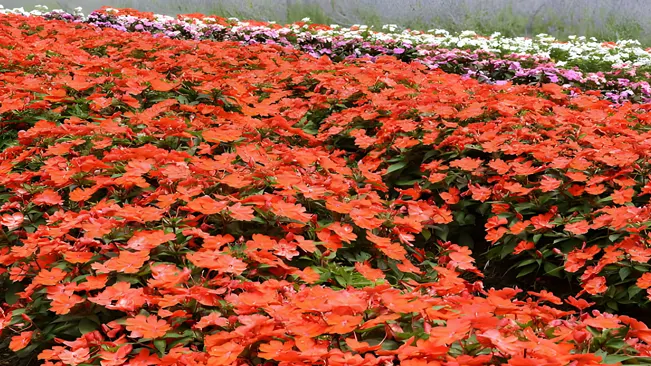
- Light Requirements: New Guinea Impatiens are unique in their tolerance for more light compared to other Impatiens varieties. However, they still perform best in partial to full shade. This means they should receive filtered sunlight or only a few hours of direct morning sun.
- Avoiding Direct Afternoon Sun: The intense afternoon sun can be harmful to these plants, leading to scorched leaves and stress. In cooler climates, they can tolerate more sun, but in hotter areas, shade during the peak hours is essential.
Well-Draining Soil

- Moisture Management: Well-draining soil is crucial as it allows excess water to flow away from the plant’s roots. This prevents the roots from sitting in water, which can lead to root rot, a common problem in overly wet conditions.
- Organic Matter: Soil rich in organic matter not only provides essential nutrients but also improves soil structure and water retention. Compost or well-rotted manure can be mixed into the soil to increase its fertility and aeration.
- pH Preference: New Guinea Impatiens prefer slightly acidic to neutral soil pH, generally between 6.0 and 6.5.
Planting
The best time to plant New Guinea Impatiens is in the spring after the threat of frost has passed. Space the plants about 8 to 12 inches apart to allow for adequate air circulation. Plant them at the same depth they were in their pots to avoid burying the stems.
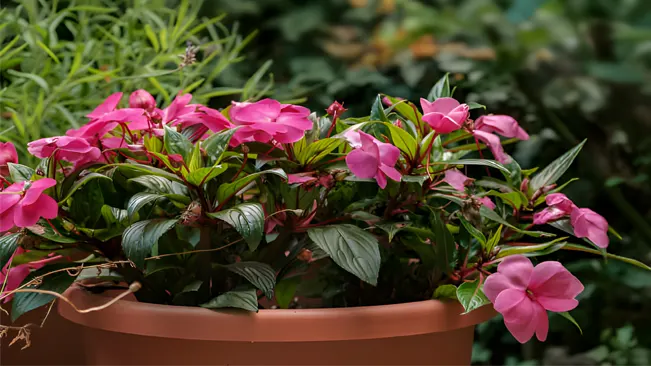
Timing
- Planting New Guinea Impatiens at the right time is crucial. Spring is the ideal season, specifically after the last frost has passed. This timing ensures that the tender plants aren’t exposed to damaging cold temperatures. Depending on your region, this could be anywhere from late March to early June.
Site Preparation
- Before planting, choose a suitable location. New Guinea Impatiens prefer a spot that receives partial to full shade, especially protection from the harsh afternoon sun. The site should have well-draining soil. It’s beneficial to enrich the soil with organic compost to provide the necessary nutrients for growth.
Spacing
- Proper spacing is important to maintain good air circulation around the plants, which reduces the risk of fungal diseases. Space them about 8 to 12 inches apart. This distance allows each plant enough room to grow and spread without competing too much with neighboring plants.
Planting Depth
- When planting New Guinea Impatiens, it’s essential to get the depth right. Plant them at the same depth they were growing in their pots. This means the soil level in your garden should match the soil level they were at in their container. Planting too deep can cause the stems to rot, while planting too shallow can expose the roots and stress the plant.
Watering
These plants require consistent moisture. Water them regularly, keeping the soil evenly moist but not soggy. Overwatering or under-watering can both be detrimental. Use mulch to help retain soil moisture and regulate soil temperature.
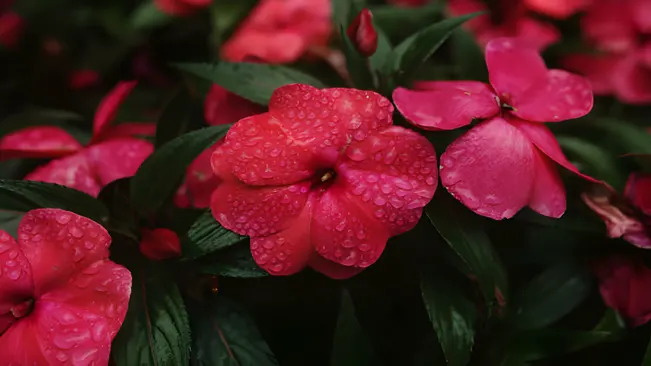
- Consistent Moisture: Their root systems are designed to take up water regularly. If the soil dries out completely, the plant can become stressed, leading to wilted leaves and a decrease in flower production.
- Avoiding Soggy Soil: While they like moist soil, they don’t fare well in waterlogged conditions. Excessively wet soil can lead to root rot, a harmful condition that can damage or kill the plant.
Tips for Effective Watering
- Check Soil Moisture: Before watering, check the top inch of the soil. If it feels dry, it’s time to water. If it still feels moist, wait a bit longer.
- Water Deeply: When you water, do so deeply. This means watering enough so that moisture reaches the roots, encouraging deeper root growth which in turn helps the plant to be more drought-tolerant.
- Morning Watering: Watering in the morning is ideal as it allows any moisture on the leaves to dry during the day, reducing the risk of fungal diseases.
- Mulching: Applying a layer of organic mulch around the plants can be very beneficial. Mulch helps retain soil moisture, keeps the soil cooler, and reduces the frequency of watering. It also adds organic matter to the soil as it breaks down.
- Adjusting to Weather Conditions: Be adaptable with your watering routine. Hotter, drier weather will necessitate more frequent watering, while cooler or rainy periods will require less.
- Container Plants: New Guinea Impatiens in containers may need more frequent watering than those in the ground, as soil in pots tends to dry out faster.
- Use of Saucers for Potted Plants: If your potted New Guinea Impatiens are sitting in saucers, be sure to empty the saucer after watering. This prevents the roots from sitting in water, which can cause root rot.
Feeding
Fertilize New Guinea Impatiens every two to four weeks using a balanced, water-soluble fertilizer. This will help promote vibrant blooms and healthy growth. Be careful not to over-fertilize, as this can lead to more foliage and fewer flowers.
- Nutrient Requirements: Like most flowering plants, New Guinea Impatiens require a balance of essential nutrients for optimal growth. Nitrogen (N), Phosphorus (P), and Potassium (K) are the primary nutrients needed, often found in a balanced fertilizer.
- Choice of Fertilizer: A water-soluble, balanced fertilizer, typically marked with equal N-P-K values (like 10-10-10 or 20-20-20), is ideal. This type of fertilizer ensures a well-rounded supply of essential nutrients.
- Frequency of Application: Feeding your plants every two to four weeks during their active growth period (usually spring and summer) is recommended. The frequency can be adjusted based on the plant’s response and the specific growing conditions.
Applying the Fertilizer
- Dilution is Key: Always follow the manufacturer’s instructions on dilution rates. Over-concentration can burn the plants.
- Application Method: Fertilizer can be applied directly to the soil around the plants. Make sure to water the plants first if the soil is dry to prevent root burn.
- Foliar Feeding: Occasionally, a foliar spray can be used for a quick nutrient boost. However, this should not replace regular soil fertilization.
Pruning and Maintenance
Regularly deadhead spent blooms to encourage new flowers. Pruning isn’t usually necessary, but you can trim back leggy stems to encourage bushier growth. Check periodically for pests like aphids and treat them promptly if found.

- Deadheading: Deadheading, or removing spent (wilted) blooms, is crucial for New Guinea Impatiens. This process not only keeps your plants looking neat but also encourages the production of new flowers. When you remove a faded flower, you’re essentially redirecting the plant’s energy from seed production back into creating more blooms and lush foliage.
- Pruning Leggy Stems: Over time, New Guinea Impatiens can become leggy, meaning their stems grow long and sparse. This often occurs when they’re stretching for light or have expended a lot of energy blooming. Pruning these leggy stems back can promote more compact and bushier growth. You can cut back the stem to just above a set of leaves, and new growth will typically sprout from this point.
- Encouraging Bushier Growth: To maintain a full and bushy appearance, you may occasionally trim the stems even if they aren’t leggy. This light pruning can stimulate the plant to produce more side shoots, resulting in a denser, more attractive plant.
- Checking for Pests: Regularly inspect your New Guinea Impatiens for signs of pests. Aphids are common and can be identified by their small, pear-shaped bodies. They usually congregate on the undersides of leaves and on new growth. Aphids can be treated with insecticidal soap or neem oil, applied according to product instructions. Be vigilant, as a severe infestation can harm the plant.
Winter Care
In colder climates, New Guinea Impatiens are treated as annuals. However, you can bring them indoors before the first frost. Place them in a well-lit area and reduce watering.
Bringing New Guinea Impatiens Indoors
- Timing: Monitor the weather forecasts and plan to bring your plants indoors before the first frost. A sudden cold snap can damage or kill them.
- Preparation: Before bringing them inside, inspect for pests and diseases. Treat any issues to avoid introducing pests to your home. Prune any dead or yellowing leaves to encourage new growth.
- Transition: Acclimate your plants to indoor conditions by gradually reducing their outdoor time over a week or so. This helps reduce shock from the sudden change in environment.
Indoor Care During Winter
- Light: Place them in a well-lit area. Ideally, they should receive at least 4-6 hours of indirect sunlight daily. A south-facing window is usually a good spot, but avoid direct, harsh sunlight.
- Watering: Reduce watering compared to the summer months. The goal is to keep the soil slightly moist but not wet. Overwatering can lead to root rot, especially in cooler, less sunny conditions.
- Humidity: These plants appreciate humidity. In dry indoor environments, consider using a humidity tray or a room humidifier.
- Temperature: Keep them in a room with consistent temperatures, ideally between 65-75°F (18-24°C). Avoid placing them near drafts, heating vents, or air conditioners.
- Fertilizing: It’s not necessary to fertilize during the winter months as the plant’s growth slows down. Resume fertilization in the spring when you notice new growth.
Preparing for Spring Return
As winter ends and temperatures start to rise, prepare your New Guinea Impatiens for returning outdoors. Gradually acclimate them to outdoor conditions in the same way you brought them in, to prevent shock from sudden temperature and light changes. Once all danger of frost has passed, they can be moved outside permanently.
Propagation
Propagate New Guinea Impatiens through stem cuttings. Take cuttings in the early summer, root them in water or a soil mix, and transplant them once they have developed a good root system.
Propagation of New Guinea Impatiens through Stem Cuttings
- Timing: The best time to take stem cuttings is in early summer when the plant is actively growing. This ensures that the cuttings are vigorous and have a higher chance of rooting successfully.
- Selecting Cuttings: Choose healthy, non-flowering stems for your cuttings. Look for stems that are firm and green. Avoid woody or overly soft stems as they may not root well.
- Cutting Length: Each cutting should be about 4-6 inches long. Make a clean cut with a sharp, sterilized pair of scissors or pruning shears. Cutting at a 45-degree angle increases the surface area for rooting and helps absorb more water.
- Preparing Cuttings: Remove the leaves from the lower half of the cutting, leaving only a few leaves at the top. This reduces moisture loss and focuses the plant’s energy on root development.
- Rooting Medium:
- Water: You can root cuttings directly in water. Place the cuttings in a jar of water, ensuring that the leafless part of the stem is submerged. Change the water every few days to keep it fresh. Roots typically start to appear within a few weeks.
- Soil Mix: Alternatively, you can root cuttings in a soil mixture. Use a well-draining potting mix, ideally one that is peat-based. Plant the cuttings in the soil, ensuring the leafless part is buried, and water gently.
- Creating Humidity: To create a humid environment that cuttings favor, cover the pot with a plastic bag or use a propagation dome. This helps retain moisture and warmth, encouraging root growth. Be sure to open the bag or dome occasionally to allow for air circulation and prevent mold growth.
- Location: Place the cuttings in a warm, bright area but out of direct sunlight. Too much sun can cause the cuttings to wilt, while too little light can slow down root development.
- Monitoring: Keep the soil or water consistently moist but not waterlogged. In the case of soil rooting, check for roots after a few weeks by gently tugging on the cuttings. If there’s resistance, roots have likely formed.
- Transplanting: Once the cuttings have developed a good root system (typically in a few weeks to a month), they can be transplanted. Carefully move them to individual pots or a garden bed, handling the delicate roots gently.
- Aftercare: Treat the newly transplanted impatiens as you would mature plants, with regular watering and feeding. Keep them in a shaded area for a few days to help them acclimate to their new environment before moving them to their final location.
Conclusion
New Guinea Impatiens are a wonderful addition to any garden, providing vibrant colors and a lush appearance. With the right care and attention, they can flourish and become a standout feature in your garden. Remember, the key to successful growth is proper watering, adequate shade, and regular feeding. With these tips, you’ll be well on your way to enjoying the stunning beauty of New Guinea Impatiens.
FAQs (Frequently Asked Questions)
- What are the ideal growing conditions for New Guinea Impatiens?
New Guinea Impatiens thrive in partial to full shade, in well-draining soil rich in organic matter. They need protection from strong midday sun to prevent leaf scorch. - How often should I water New Guinea Impatiens?
Water them regularly to keep the soil evenly moist, but not waterlogged. It’s important to ensure good drainage to prevent root rot. During hot, dry spells, daily watering might be necessary. - Do New Guinea Impatiens need fertilizer?
Yes, fertilize them every two to four weeks during the growing season with a balanced, water-soluble fertilizer to promote healthy growth and vibrant blooms. - Can New Guinea Impatiens tolerate full sun?
They prefer partial shade and can struggle in full sun, especially in hot climates. If they’re in a sunnier spot, they’ll need more frequent watering to prevent stress. - How do I deal with pests on my New Guinea Impatiens?
Check regularly for pests like aphids. If you find any, treat the plants with insecticidal soap or neem oil, following the product instructions. - Should I deadhead New Guinea Impatiens?
Yes, regularly remove spent blooms (deadheading) to encourage the plant to produce more flowers. - How do I propagate New Guinea Impatiens?
Propagate them through stem cuttings. Cut a 4-6 inch stem, remove the lower leaves, and root in water or a soil mixture. Once roots have developed, transplant them. - Can I grow New Guinea Impatiens in containers?
Absolutely! They do well in containers. Ensure the container has good drainage and use high-quality potting soil. - How do I winterize New Guinea Impatiens?
In colder climates, they’re treated as annuals. However, you can bring potted plants indoors before the first frost, placing them in a well-lit area and reducing watering. - How much space do New Guinea Impatiens need?
Space them about 8 to 12 inches apart. This spacing allows adequate air circulation and helps prevent disease.

Kristine Moore
Forestry AuthorI'm Kristine Moore, a seasoned garden landscaping professional with over 30 years of experience. My extensive career has been dedicated to transforming outdoor spaces into stunning, sustainable landscapes. With a deep understanding of horticulture, design principles, and environmental stewardship, I have become a respected figure in the field, known for creating harmonious, visually appealing, and eco-friendly gardens. My commitment to excellence and continuous learning in landscaping trends and techniques has solidified my reputation as an expert in garden design and implementation.




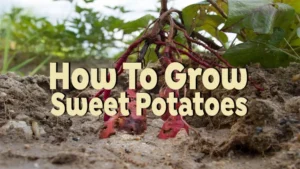




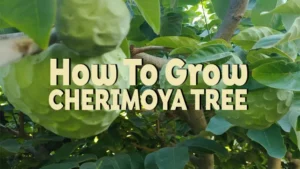



Leave your comment